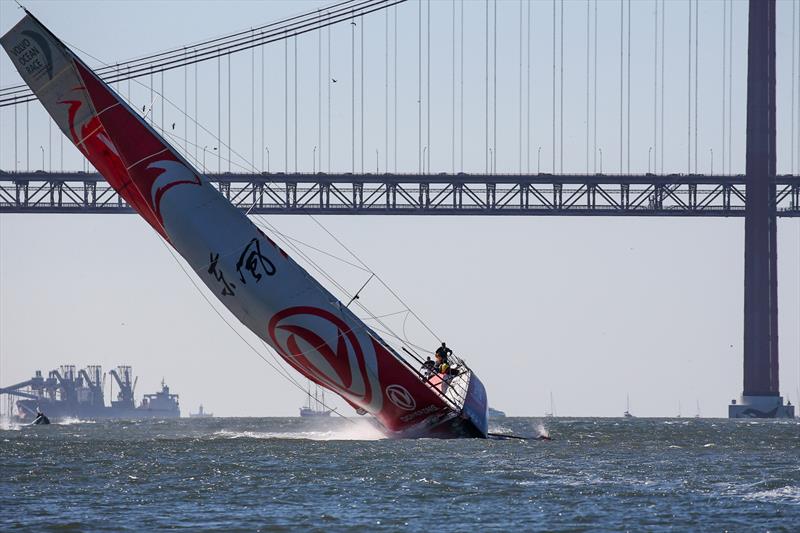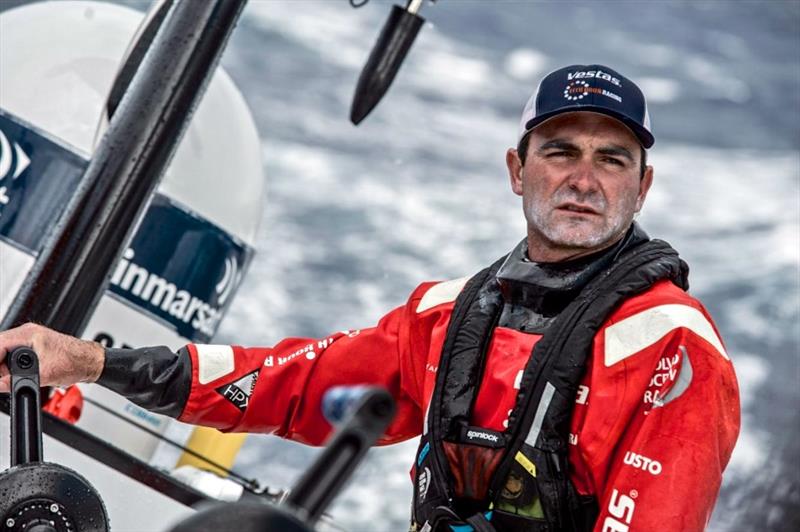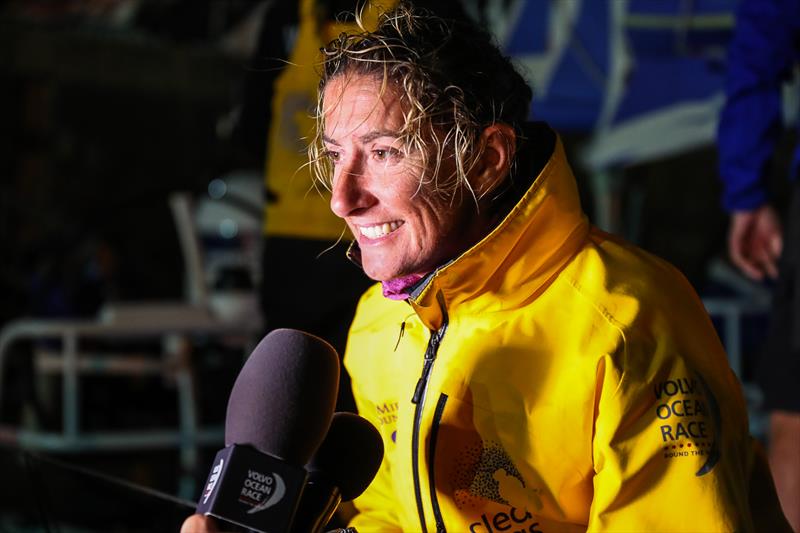
Next stop Cape Town, as Dongfeng Race Team lead the Volvo Ocean Race fleet out of Lisbon
by Volvo Ocean Race 5 Nov 2017 08:48 PST
5 November 2017

Start of Volvo Ocean Race Leg 2: Lisbon to Cape Town © Jesus Renedo / Volvo Ocean Race

Charlie Enright, Vestas 11th Hour Racing - Leg 2, Volvo Ocean Race ©Martin Keruzore / Volvo Ocean Race

Dee Caffari after the Volvo Ocean Race Leg 2 finish in Cape Town ©Ainhoa Sanchez / Volvo Ocean Race
previous next
The Volvo Ocean Race fleet is charging into a challenging first night at sea with winds over 30-knots forecast...
Dongfeng Race Team converted a strong start into an early lead as the Volvo Ocean Race fleet embarked on Leg 2, a 7,000 nautical mile race from Lisbon to Cape Town.
Conditions were perfect for the leg start, with bright blue skies, and a 15-20 knot Northerly breeze that allowed the fleet to reach up and down the Tagus River past the city front of Lisbon.
After exiting the river and heading offshore past the protection of Cascais, the wind is forecast to build to over 30-knots, with a heavy ocean swell near 4-metres. It will be a fast and challenging first night at sea as the teams charge to the southwest.
"It's going to be fast," said Dongfeng skipper Charles Caudrelier. "We have been preparing for this, training in strong winds for six months, so I hope we are ready. We have some good drivers in these conditions so I hope we will be fast."
And indeed, within 15-minutes of clearing the mouth of the river, the fleet was already seeing over 30-knots of wind and Dongfeng Race Team recorded a boatspeed of nearly 33-knots.
Charlie Enright, the skipper of race leader Vestas 11th Hour Racing was in a strong position early, but appeared to be caught out with too much sail up for the final stretch down the river, and fell back to fifth place.
"We're confident, but not cocky," Enright said before the start. "We want to take what we've learned and apply it to leg 2. It's going to be a much different leg. It will be a lot more boatspeed oriented and we're looking forward to that."
"The real race starts now," said Xabi Fernández, the skipper of MAPFRE. "Today we will sail in a couple of days in heavy winds. Everyone will be competitive so we'll need to go as fast as we can."
Leg 2 – Position Report – Sunday 5 November (Day 1) – 15:00 UTC:
1. Dongfeng Race Team -- distance to finish – 5,094.2 nautical miles
2. Team Brunel +0.2nm
3. MAPFRE + 0.6
4. Sun Hung Kai/Scallywag +0.9
5. Vestas 11th Hour Racing +1.6
6. Turn the Tide on Plastic +1.8
7. team AkzoNobel +1.8
www.volvooceanrace.com
MAPFRE lead the fleet at the start of Leg 2 en route to Cape Town (from MAPFRE)
Winds of between 20 and 24 knots in the mouth of the River Tagus, with peaks of 30 as the fleet entered the Atlantic for the start of Leg 2 of the Volvo Ocean Race. Xabi Fernández's MAPFRE already lead the fleet as them make their descent to the Canary Islands.
An intense and busy start on the waters of Lisbon for the second leg of the Volvo Ocean Race. At 15:00h Spanish time, the fleet set off with northerly winds of between 20 and 24 knots, on the first real ocean leg of this edition of the round-the-world race from the Portuguese capital to Cape Town, South Africa. 7000 miles of uninterrupted sailing awaits, and MAPFRE has conscientiously prepared, maintaining their firm objective to fight for victory right up until the very end.
The boats left the dock to the applause of thousands of fans in the Race Village in Lisbon, including the well-known red flock of "Ñetifans", family, and friends, offering their support and an affectionate farewell to Xabi Fernández's crew, before the team set off on the second longest leg of the race.
Before heading south, the seven boats completed a windward-leeward course in the River Tagus, sailing under the 25 de Abril Bridge. Not the best start for MAPFRE, but the Spanish VO65 was not long in making up distances, to position themselves at the front of the pack for the first miles of sailing in the Atlantic.
The next few miles will be crucial, and predictions show that the fleet will be facing conditions of over 30 knots of wind, as they head down towards the Canary Islands.
An intense start to the leg
It will not be an easy start to the leg, but a clearly fast and intense beginning for the seven teams on the fleet. The meteorological conditions are already showing that the first few miles will be marked by strong winds, which could get tougher over the course of today, and peak at 35 knots tonight. The fleet were already sailing very fast along the Portuguese coast, and MAPFRE were heading the group.
The approach to the Canary Islands, the Doldrums and the entrance into the Southern Ocean are all key points in the leg. Xabi Fernández's team are well aware that any options of victory depend on leading each of these different transition points, although with over 7000 miles of racing ahead of them, anything might happen.
Quotes:
Xabi Fernández, Skipper
We are always aware of other teams bringing reinforcements on board, for varying reasons, sometimes injury or circumstances, and we have seen in this leg well-known offshore sailors such as Chuny Bermúdez and Chris Nicholson, joining teams and bringing them added quality. We have always known that all the teams were going to be very competitive, and I think it gives extra added value to the racing, and also means that as much as we are able, we have to do everything even better still.
In this edition we have seen that the start is an important part of the race, because you have already begun to direct things a little. However, with 20 days of sailing ahead of us, we can't get too obsessed by it, particularly with a night like tonight to experience, and the Doldrums to get through, the start will end up being a mere anecdote.
Ñeti Cuervas-Mons, bowman and boat captain
We are finally heading south. Up until now, we haven't really had the feeling that we were in a round-the-world race. Now we are going to be several weeks at sea, and it will be the first real test for both the boats and for the crews. This is what we have been preparing for all this time, and we hope it is going to go well.
The first few days are going to be quite tough, with quite a lot of wind, and we will see which is the fastest boat. We will then go through the Canary Islands and Madeira, which is always quite tricky, and then onto the equator. It is going to be a very fast leg, and I think that in 20 or 21 days we will be in Cape Town. In 15 days' time we should be at 40º South, in a flash!
The predictions for tonight are showing quite a lot of wind, which was the same for the Gibraltar Straits, but with bigger seas, so we already know which sail we will be using, and we will also see what the others are doing. It is all quite well planned, although we all know that from what might be planned to what actually happens, everything can change. The most important thing for us is not to break anything tonight, because it is going to be a tough one, so we will take things calmly.
Joan Vila, navigator
Tonight we are going to have quite a cold, northerly wind, and about 30 knots. We might have to gybe during the night, to stay with the maximum wind, which is like a small wind corridor running from the west on the Portuguese coast down to the Canaries, and then onto Madeira. The secret to the first part of the leg is to stay with as much wind as possible.
Tonight will quite probably be decisive for the first week, but the leg is a long one and there is a lot to get through: the Doldrums, the South Atlantic and a lot of opportunities for position changes at the front, but tonight will definitely define positions over the first few days.
Team Brunel under way to Cape Town (from Team Brunel)
Team Brunel is under way to Cape Town after a promising start in Leg 2 of the Volvo Ocean Race. Skipper Bouwe Bekking steered his boat in first over the starting line. After going a bit upstream the fleet rounded a mark near the old city centre and then set a definitive course towards open sea. Team Brunel left Lisbon for the open sea in second place.
Heavy first night forecasted
The sailors are facing a heavy first night with wind speeds up to 30 knots with a ocean swell near 4-metres as the teams charge to the southwest. For the young Dutchman Carlo Huisman it's his first Leg with a duration of over a week. Prior to the Leg he was realistic.
Carlo Huisman: "We're having an average 20 knot winds for the coming four days. It will be a fast ride. During the first couple of days it will be essential to keep everything in one piece. But also have to keep our feet on the gas pedal because we want to win."
Tiaro Pires legjumper
Tiaro Pires is a surfing legend. He was de first Portuguese surfer to make his debut on the World Tour and is known as the godfather of Portuguese surfing.
Pires: "It was awesome. I had zero expectations but this was so cool. A truly unique experience. When they told me it was time to jump, I really had to flip the switch. The jump was pretty high and we were going very fast. But I'm so happy I did this. It was a truly unique experience. I really hope they do well and wish them the best. They surely looked like they know what they're doing."
Team AkzoNobel powers out of Lisbon on Leg 2 of the Volvo Ocean Race (from Team AkzoNobel)
Team AkzoNobel has left Lisbon, Portugal on the 13,000-kilometer second leg of the Volvo Ocean Race to Cape Town, South Africa. The team passed the Lisbon departure marker in sixth place, shortly after 1500 UTC this afternoon, at the end of a short inshore section in the Tagus river.
Moments earlier the crew waved goodbye to their celebrity guest, Portuguese Paris Dakar Enduro motorcycle rider Hélder Rodrigues, who – right on cue ¬– bravely leapt from the back of the speeding yacht. Watch his exit off the boat here.
Safely retrieved from the water by the team's support boat, Rodrigues said his ride aboard the team AkzoNobel boat had been thrilling.
"What a ride. The teamwork on the boat is amazing," he said. "They are a great crew and I wish them the best of luck for the rest of the leg to Cape Town."
Winds are forecast to build to 35 knots overnight meaning the nine team AkzoNobel sailors are in for some exciting sailing overnight when boat speeds are expected to top 25 knots. As well as the thrill of sailing in such windy conditions, there can also be spills and the team's strategy is to avoid damaging the boat or themselves on the first night.
"We just need to rein ourselves in and keep it all together," said new watch captain Chris Nicholson (AUS) who joined the team this week. "We have a strong team and a good set up here, so we all now need to focus on sailing the boat as well as we can on this leg."
Over the next 48 hours the fleet is expected to power its way west into the open Atlantic, before turning south somewhere in the vicinity of the island of Madeira. However, the possibility that an alternative shorter route along the African coast could come into play will keep the skippers and navigators glued to their laptop screens over the next 12 hours or so.
"Right now it looks like west is best," said team AkzoNobel skipper Simeon Tienpont before the start. "We will be watching the weather systems closely and we could have a tactical decision to make in about 35 hours whether to cut down through the middle of the Canary Islands.
"The goal is to set up for a smooth transition through the Doldrums [an area of light winds and thunderstorms near the equator] in a little less than a week's time. Right now, that's as far as we are focused on."